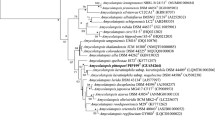Abstract.
Hydrophobins are fungal cell wall proteins which play a crucial role in cell adhesion and aggregative processes. We have identified a new hydrophobin cDNA (hydPt-3) in the symbiotic mycelium of Pisolithus tinctorius (putative P. albus) during the formation of ectomycorrhizae around eucalypt roots. This sequence is highly divergent from two other previously identified Pisolithus symbiosis-regulated hydrophobins, hydPt-1 and hydPt-2. Also, expression analyses demonstrated that hydPt-3 is up-regulated during the formation of ectomycorrhizae. In contrast to phytopathogenic fungi, changes in glucose or ammonium concentrations in the growth medium did not influence the accumulation of any Pisolithus hydrophobin mRNAs. This suggests that other factors act as regulators of hydrophobin gene expression in ectomycorrhizae.
Similar content being viewed by others
Author information
Authors and Affiliations
Additional information
Electronic Publication
Rights and permissions
About this article
Cite this article
Duplessis, S., Sorin, C., Voiblet, C. et al. Cloning and expression analysis of a new hydrophobin cDNA from the ectomycorrhizal basidiomycete Pisolithus . Curr Genet 39, 335–339 (2001). https://doi.org/10.1007/s002940100224
Received:
Accepted:
Issue Date:
DOI: https://doi.org/10.1007/s002940100224




